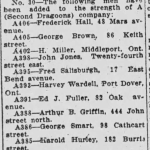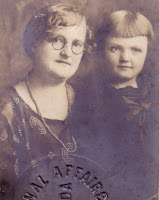Post updated February 10, 2024 to include more info about Arthur’s wartime experiences. October 10, 2023 to include Dorothy’s birth record and 1931 Census.

When Arthur Bird Griffin was born on November 1, 1888, in Backwell, Somerset, England, his father, John Griffin (1860-1937), was 28 and his mother, Sarah Jane (née Goodland) (1857-1931), was 31. Arthur had three brothers and one sister.
Arthur was by all accounts a very gentle man. He was an artist who dabbled in many mediums including pencil, paint, wood and even fabric. His descendants have evidence of his works proudly displayed in their homes.Arthur’s skill with fabrics was evident in his choice of profession. He was employed as a weaver.
In 1904 (confirmed by the 1931 Census although I haven’t found a shipping record), Arthur emigrated from England to Hamilton, Ontario, Canada. His name appears on the Nominal Rolls for the 91st Regiment, Argyll and Sutherland in Hamilton, Ontario for that year. He is listed as a private in 1907 and Corporal by 1910. According to the Argyll and Sutherland Highlanders’ Museum:
The Argyll and Sutherland Highlanders of Canada (Princess Louise’s), is a Highland infantry unit of the Canadian Forces Army Reserve. The infantry is the main fighting branch of the Canadian Forces, and is the backbone of the army.
The Regiment was gazetted in 1903 as the 91st Regiment Canadian Highlanders.
I haven’t been able to locate Arthur on the 1911 Canadian Census, but an article in the Hamilton Spectator on September 25, 1911 confirms he was living in the city. Arthur raised and raced pigeons.


On April 7, 1914, Arthur and his brother, Charles disembarked the S.S. Arabic, which travelled from Liverpool to Boston, Massachusetts, USA. His final destination was Hamilton, Ontario. This record indicates that Arthur had already met his future wife. His stated intention on the documentation is to visit with Samuel Moore, his future father-in-law, at 453 John Street in Hamilton, Ontario (the house is no longer there).

The S.S. Arabic was a member of the White Star line (made infamous for another of its ships, which you might know under the name of “Titanic”).

On May 7, 1915, the British cruise liner Lusitania, en route from New York to Liverpool, England, was struck and sunk by a torpedo from the German U-boat U-20. The swift-moving vessel was carrying 1,959 passengers, including men, women, and children, of whom 1,195 tragically lost their lives. Among those were 23 individuals from Hamilton, Ontario. Notably, one of the families that did not survive included J.M. Young, the president of the Hamilton Cotton Company, which was coincidentally where Arthur was employed. An article in the Hamilton Spectator dated May 10th says that several of J.M. Young’s employees were motivated to enlist after learning of his death. Arthur, among the group, was declared not medically fit at the time.

The sinking of the Lusitania infamously led to the United States entering the war. Coincidentally, the S.S. Arabic, the ship that brought Arthur to Canada, was also sunk by a German submarine in August 1915.


Whatever medical issues precluded his enlistment in May were somehow overlooked when Arthur re-enlisted in August, 1915. His enlistment paperwork suggests that he had five years of military service, three years with the Highlanders, and two years prior to that with the 2nd Canadian Dragoons. His occupation on the enlistment form is a “weaver.”
Arthur was among 540 men who enlisted at the John W. Foote Armouries at 200 James Street North in Hamilton that week, where the Argyll and Sutherland regiment was based. He was added to the strength of the A (Second Dragoons) company:

During the First World War, the Argyll and Sutherland regiment acted as a training unit, providing 145 officers and 5,207 other ranks for service in the numbered battalions of the Canadian Expeditionary Force.
Just a week after enlisting, Arthur married Lily Moore on September 8, 1915, at St. Luke’s Church in Hamilton, Ontario. The wedding was witnessed by Lily’s sister Dora and her husband Albert Hulme. Arthur’s occupation is already listed as “soldier.” Lily’s name is corrected on the certificate: her name was always Lily, and not Lillian (as it appears the chaplain assumed).

When Lily Moore was born on September 19, 1891, in Chorley, Lancashire, England, her father, Samuel Moore (1868-1951), was 22, and her mother, Elizabeth (née Longworth) (1869-1951), was 22. She had one sister.
The couple had three daughters over the next twelve years:
- Dorothy Irene Griffin (1917-2010) married George Edward Webb (1915-1957)
- Gladys May Griffin (1922-2001) married Ernest Charles Prosser (1919-1985)
- Grace Gwendolyn Griffin (1927-2017) married Michael David Citoren (1925-1987)
Arthur was subsequently sent to Camp Niagara for training. I believe he is in this photo in the top row, second from the left.

Arthur and Lily’s first child, Dorothy Irene (1917-2010), was conceived before Arthur shipped out and was born at 453 John Street on February 11, 1917.

On September 6, 1916, the Hamilton Spectator reports the death of Cpl. Stanley Brooks, who was reportedly a “chum” of Arthur. The article suggests they met at Camp Niagara and they had been dispatched to the same section at the front. Arthur is also reported wounded – likely in the same battle.

It appears that Lily, who would have been home pregnant with Dorothy was not given further information and was very worried about Arthur. A cable was sent to relieve her worry – and an article on September 25, 1916, confirmed that Arthur’s mother sent a cable confirming that he was “safe on September 10.” The article suggests she was living at 11 Highland Avenue in Hamilton.

There is a mention of the September skirmish in the book Toronto’s Fighting 75th in the Great War 1915–1919.

I suspect the dates in the above are incorrect. When researching the death of Cpl. Brooks, I discovered discrepancies in the reported date of his death – which varied several dates between August 21-26. When Arthur was injured again in December 1917, an article in the Hamilton Spectator confirmed the details of the September 1916 incident. He was knocked unconscious when some of the men (possibly Cpl. Brooks?) somehow accidentally used dynamite to make hot water for tea. The article suggests two other members of the party (I’m assuming Edward Hughes and Stanley Brooks) were blown to pieces. The December article confirms that Arthur participated in the Battle of the Somme, the taking of the Regina Trench, Vimy Ridge, and subsequent engagements without injury. However, in December 2017, he was gassed.

This photo of Lily and Dorothy was likely taken in September or October of 2017 and sent to Arthur on the front.

A note on the back reads “This picture received by ABG in Belgium 1917. Was gassed and left France 2 weeks later.” (This post relates to the other soldiers that Arthur was with during that period.)
Arthur’s children later said that he wouldn’t talk about the war, but their mother said he was much changed by it. He continued to have issues with his lungs for the remainder of his life.
Upon returning from the war, Arthur returned to his job at the cotton mill. Given his facility with art and his experience with textiles, it was a good fit.
Dorothy’s sister Gladys May (1922-2001), was born on October 17, 1922.

Just prior to Gladys‘ birth, in 1922, the family took a trip back home to visit with the Griffins. They left aboard the Empress of France, arriving in Southhampton, UK in September and returned via the Minnesoda on October 12, 1922. Dorothy was about five years old, at the time of the trip, and they arrived back in Canada just five days before Gladys was born. Dorothy and Lily are in the same passport photo in the documents.
The couple’s third daughter, Grace Gwendolyn (1927-2017), was born in 1927. After having two girls already, Arthur had really been hoping for a son. As a result, Grace was nicknamed “Sonny.”
Several newspaper articles following the war suggest that Arthur was very active with the local cricket club. In 1926, he made the finals for an interprovincial match.


The 1931 Census confirms that while Arthur was at war and for some time after, the couple lived with Lily’s parents at 299 Grovesnor Road North in Hamilton. At the time of the census, Arthur was a foreman at a cotton mill making $1700/year.
1931 Canadian Census (image via Ancestry.com)


In 1952, after the death of Lily’s parents, with all of their children married, the couple purchased 1484 Main Street East, Hamilton.

Arthur died on April 30, 1972, in Hamilton, Ontario, at the age of 83.

Lily survived for more than a decade after her husband, initially moving in with her daughter Dorothy, who had also been widowed and then into a St. Elizabeth’s Nursing Home in Hamilton. Lily died on May 16, 1985, in Hamilton, Ontario, at the age of 93. Her obituary reads:
Griffin, Lily – Passed away peacefully at St. Elizabeth’s Nursing Home in her 95th year. Widow of Arthur Bird Griffin and dear mother of Dorothy Webb of Hamilton, Gladys Prosser of Hamilton and (name removed). Will be sadly missed by four grandchildren and four great-grandchildren. Friends may call at the LG WALLACE FUNERAL HOME, 151 Ottawa Street North – Thursday 7-9 p.m. and Friday 2-4 and 7-9 p.m. Complete funeral service in Chapel Satruday at 11 a.m. Canon Robert E. Adams of St. James the Apostle Church officiating. Cremation will follow. The family would appreciate donations to your favourite charity.
The couple had three children, four grandchildren, four great-grandchildren, and as of the time of writing this piece, there were seven great-grandchildren.
Main image: Top: Arthur Griffin and Ernest Prosser
Middle: Dorothy (Griffin) Webb and Lily (Moore) Griffin
Bottom: Gladys (Griffin) Prosser and Dorothy’s children
Photo inside the front window of the home on Main Street









